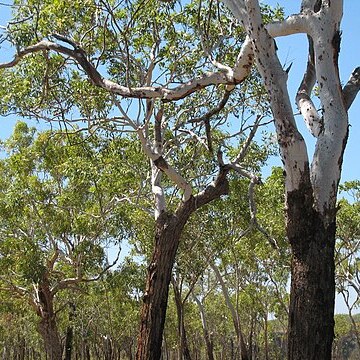Tree to 30 m. Bark ±stringy, spongy, fissured, grey or rusty red for 1/4–1/2 of height, then smooth and white above. Juvenile leaves ovate, green, stellate hairy. Adult leaves sometimes falcate, acute or acuminate; lamina 9–16 cm long, 1–3.5 cm wide, green, discolorous; lateral veins distinct, at 45°–65°; intramarginal vein up to 1 mm from margin; petiole flattened, 12–20 mm long. Umbels 7-flowered; peduncle terete or angled, 12–35 mm long; pedicels absent or to 5 mm long. Buds ovoid or clavate, striate or ribbed, glaucous; operculum hemispherical to conical, 8–13 mm long, 10–12 mm wide; hypanthium truncate-ovoid, 10–12 mm long and wide. Fruits ovoid to urceolate, sometimes glaucous, often sessile, 30–60 mm long, 17–50 mm wide, usually prominently ribbed; valves 3. Seeds cuboid.
More
An erect tree. It grows 10-30 m tall and has a tall trunk. It can spread 10-20 m wide. The lower bark is dark. It is loose, rough and papery and peels off to reveal smooth white bark. The young growth has a whitish bloom. The leaves are leathery and sword shaped. The blade is 8-15 cm long and 2-6 cm wide. The flowers are orange in clusters of about 7. These are on thick stalks in the axils of leaves. The fruit are ribbed. They are barrel shaped woody capsules. They are 3-6 cm long by 2-5 cm wide.



